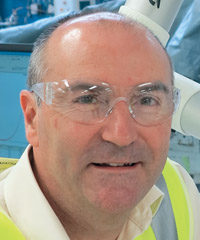Technology
New Boeing technology will mean fewer parts
Building more efficient commercial aircraft is a constant challenge for planemakers. In Melbourne, Australia, Boeing scientists are pushing the industry’s boundaries in more ways than one.
November 1st 2013
Boeing Aerostructures, the manufacturer’s second largest research and development laboratory, at Fisherman’s Bend near Melbourne, Australia, is within a few years of introducing breakthrough technology that will dramatically improve the production of major carbon fibre parts for its big jets, including the B787 Dreamliner. Read More »
 |
| 'What we are doing here is making a game change and ultimately the cost of the product' |
| Michael Edwards General Manager, Research & Technology, Australia Boeing Aerostructures |
Scientists at the facility have produced a prototype B787 wing flap, using new resin infusion methods, which will dramatically reduce the number of parts involved in their production, reduce the weight, cut costs and lift productivity. The wing flap was shown to Orient Aviation during a visit to the Melbourne technology centre, part of Boeing Aerospace Australia.
Michael Edwards, general manager Boeing research and technology, Australia, said use of the technology on the production line would have “step change impacts on costs and productivity … not just single figure percentages, but very significant percentage changes and dollars savings”.
The research laboratory functions alongside a production line that produces carbon fibre ailerons for the B737, leading edge devices for the B747-8, rudders and elevators for the B777 and flaps and ailerons for the B787. The new technology will be introduced once it has received regulatory approval..
Researchers rate the progress of potential new production methods on a scale of one to 10. “When they measure six its full-scale practical development. When they reach seven or eight we start handing them over to the factory… this development has already gone beyond that phase,” said Edwards.
He said it would be “within single figure years” before the latest technology was an inherent part of the production line.
“If you can co-infuse a whole lot of structural detail into one component, it is driving improvement through eliminating detailed parts. Anything we can do that removes the number of parts required and gives us the same performance in the end product makes it easier,” said Edwards.
“If we can reduce the number of parts that need to be assembled we are reducing the number of drill holes and fasteners and reducing the weight and improving the productivity.”
Resin infusion allows larger, more complex parts to be manufactured. It is regarded as the future of carbon fibre production.
Applying laminate engineering and resin infusion technology simultaneously means parts will be 30% stronger and lighter than traditional fibreglass laminate.
“What we do here isn’t just about incremental change, it is about making a game change and ultimately the cost of the product,” said Edwards.
The Melbourne facility has become a world leader in resin infusion composites research. “Resin infusion composites is really Australian-centric. The group here is the centre of expertise for this particular technology which has great promise to grow separately,” added Edwards.
The use of “light” robotics on the production line and elsewhere is also being studied in Melbourne. Assembly line robots are usually large and costly. Boeing is researching the use of smaller, off-the-shelf robotics that can streamline processes.
“The robots we use are very expensive. So we are looking to see if we can reduce the size of the robot, make it cheaper but smart in the way it operates,” said Edwards.
Scientists want the small robots to conduct repairs on in-service aircraft as well as at the factory. “We are at the early stage of demonstrating what light robotics can do. We are making a big investment in that space,” said Edwards.